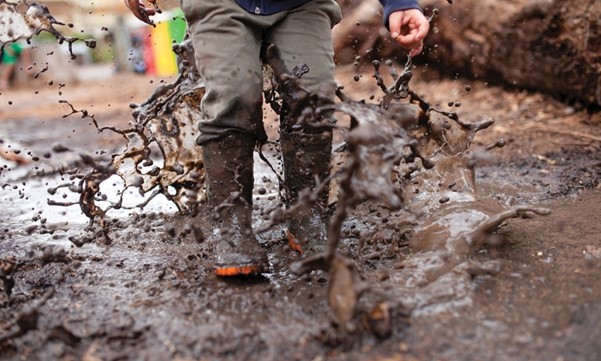
With younger generations spending so much time on screens and devices, nurturing their connection to the natural world is vital, both for their health and that of the planet.
For many of us, our strongest childhood memories revolve around time spent outdoors, playing chasey, climbing trees, riding bikes, splashing in puddles, or simply lazing on the lawn.
Getting home from school was all about dropping the bag, changing out of uniform, then heading outside until “dinner is ready” was shouted from the doorstep, and back we came. Happy days indeed. However, the call of the back yard and beyond seems to have been muted for a generation of children who are increasingly swapping green time for screen time.
The draw of instant entertainment, combined with smaller gardens and time-poor parents, are all factors that keep young eyes glued to TVs, computers, smartphones, tablets, and video consoles.
As adults, we understand the benefits that spending time gardening – or simply being outdoors – brings in helping to lower blood pressure, reduce stress and just make us feel so much better. The same applies to children.
Vital assistance for a child’s brain development is only as far away as the back door. Playing outside gives young minds an opportunity to be creative, solve problems and develop their fine motor skills. When outdoors and interacting with other children or adults, conversations had in a sand pit, up a tree or building a cubby all provide a platform to learn and advance language skills. Connecting children with nature is also a wonderful way to improve concentration levels.
It can be a struggle to stick to the recommendations of no screen time for children under two years of age, one hour for the under-fives and limiting non-educational exposure for those older.
Parents have to find ways to swap the stimulating shapes, colours and noises of screens for the smells, textures and sounds of nature, shifting enjoyment from instant gratification to a gentler but equally satisfying experience.
Nature Play SA was established in 2014 by Sarah Sutter, a qualified teacher and former professional netballer, with a vision to get more children outside and make play part of every day. Joined by general manager, Jason Tyndall, an educator and ecologist, they and their dedicated team have turned that vision into an energetic and continually evolving success.
This not-for-profit organisation’s core belief is that spending time in nature fosters deeper connections with the environment and ourselves. As curiosity and wonder transform into a desire to learn, a new world of understanding, appreciation and respect can unfold. Their challenge was finding a way to link free play into a modern world that is filled with screen time, homework, structured sporting activities and an increasingly sedentary lifestyle.
Starting small, Nature Play SA’s first activity was cubby-house building in the Adelaide Botanic Garden, which attracted 100 people. Subsequent events saw increased interest, leading to their watershed moment in 2017 at Kuitpo Forest when they hosted a range of child-friendly activities – including nature walks, kite flying and rope courses – that attracted more than 8000 attendees. Expecting 800, the staggering turnout demonstrated loud and clear the real appetite families have for spending time outdoors.
Working closely with the National Parks and Wildlife Service, Nature Play SA now run a series of programs through early learning centres and schools, along with workshops designed to develop a love of nature for children and adults alike.
Parents are children’s greatest influencers, which means they can inadvertently create barriers that discourage children from going outdoors.
As Jason Tyndall says, “The word ‘mud’ to an adult means washing, but to a child it means fun and a sensory overload for both hands and feet. A set of play clothes helps reduce that issue. It’s about realigning your thoughts and bringing out the inner child in us all. Take off your shoes and socks and join your kids, let the silky mud ooze through your toes, I bet it puts a smile on your face”.
Realigning an adult view by turning negative comments into positive ones resonates with children. While a rainy, cold day may not be something you would usually admire out loud, saying that rain is great for the garden, helping plants and our bushland survive, makes a strong positive statement that good things happen outdoors.
While a child’s safety is always important, Sarah, Jason and the team take the view that all the skipping, jumping, climbing, and running while outdoors may come with a few scratches and scrapes. It’s about matching the risk with the reward.
Their goal is to help children connect to nature and create a lifelong bond. Listening to the birds, digging for worms, lifting pots and watching slaters scurry, there is always a lot going on – you just have to look. Sowing the seed of love for nature early on creates the strongest advocates for the future stewardship of our environment.
Recognising that turning screen time into green time is an incremental process and one that needs to fit within a family’s capacity, Nature Play SA suggest starting by counting time spent indoors on screens and supplementing an outdoor family activity to balance out.
Here are some ways families can connect with nature at home:
Gather old pots, pan, spoons and measuring cups to create an outdoor kitchen. Can you make a layered mud cake?
Start in the kitchen and create a meal. Lay out a rug on the lawn and have a picnic in the back yard.
Mark out and name a plot or pot for every family member. Choose your favourite spring veggie or herb and plant seeds or seedlings. Pat them down and water in. You will need to visit that planting regularly to check and care for it.
Collect flowers from around the yard, then place them in between some newspaper and put a heavy book on top. Change the paper daily until it’s dry. Cut out cards and stick them on, these make wonderful gifts.
Take out a piece of paper and coloured pencils. Each member of the family chooses a plant, bird or animal to sketch. Hang the drawings up inside to create your own garden art gallery.
Try your hand at flower arranging. Snip off blooms and greenery, bunch together and tie the base, then pop into a vase to decorate the dining table.
Set up a tent in the back yard, then take in a cushion, blanket and some healthy snacks. Rainy days are wonderful for this. Close your eyes and listen as the droplets beat on the fabric.
Of course, there are also plenty of fun ways families can get out and about in winter:
Put on some waterproofs and gumboots and pop up the umbrella, then take a family walk in the rain.
Even better if there is a running creek nearby where you can stop and hear the babbling water. Drop a leaf in – see if you can keep up with it running on the bank.
Take advantage of those filling creeks and streams – head to Morialta Falls, Waterfall Gully or Ingalalla Falls and watch the water cascade and roar.
The Nature Play SA website is a wonderful resource for so many backyard activities and family-friendly places to visit.
This article first appeared in the August 2022 issue of SALIFE magazine.
Words: Kim Syrus


